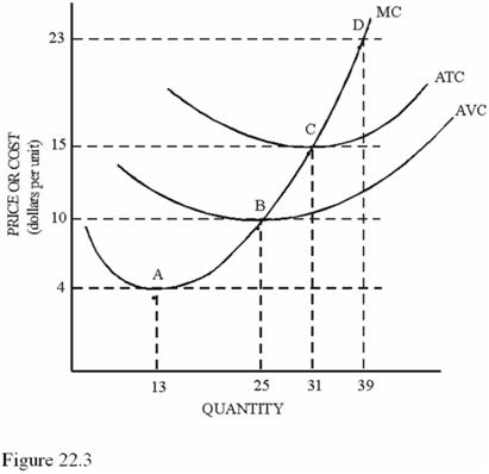A) Explicit and implicit costs while accountants recognize only implicit costs.
B) Explicit and implicit costs while accountants recognize only explicit costs.
C) Only explicit costs while accountants recognize only implicit costs.
D) Only explicit costs while accountants recognize explicit and implicit costs.
Correct Answer

verified
Correct Answer
verified
Multiple Choice
Suppose a firm has an annual budget of $200,000 in wages and salaries, $75,000 in materials, $30,000 in new equipment, $20,000 in rented property, and $35,000 in interest costs on capital.The owner/manager does not choose to pay himself, but he could receive income of $90,000 by working elsewhere.The firm earns revenues of $360,000 per year.To receive a normal profit, the firm described above would have to
A) Experience $10,000 less in cost.
B) Receive $90,000 more in revenue.
C) Receive $10,000 more in revenue.
D) Do nothing since it already earns a normal profit.
Correct Answer

verified
Correct Answer
verified
True/False
When a firm sets its price on the basis of the price being charged by other firms in the market, there is evidence that the firm has market power.
Correct Answer

verified
Correct Answer
verified
Multiple Choice
In making an investment decision, an entrepreneur
A) Treats all costs as variable.
B) Makes a shutdown decision if price is below average variable cost.
C) Must take account of diminishing returns to fixed factors.
D) Decides the level of output to produce.
Correct Answer

verified
Correct Answer
verified
True/False
The production decision is another term for the investment decision.
Correct Answer

verified
Correct Answer
verified
True/False
A perfectly competitive firm has no market power.
Correct Answer

verified
Correct Answer
verified
Multiple Choice
Adam Weed is the owner/operator of a flower shop.Last year he earned $250,000 in total revenue.His explicit costs were $175,000 paid to his employees and suppliers (assume that this amount represents the total opportunity cost of these resources) .During the year he received three offers to work for other flower shops with the highest offer being $75,000 per year.Which of the following is true about Adam's accounting and economic profit?
A) Accounting profit = $75,000; economic profit = $0.
B) Accounting profit = $175,000; economic profit = $75,000.
C) Accounting profit = $75,000; economic profit = negative $100,000.
D) Accounting profit = $0; economic profit = negative $75,000.
Correct Answer

verified
Correct Answer
verified
True/False
The primary objective of the producer is to find the rate of output that maximizes profit.
Correct Answer

verified
Correct Answer
verified
Multiple Choice
In making a production decision, an entrepreneur
A) Decides whether to enter or exit the market.
B) Decides what level of output will maximize profits.
C) Determines plants and equipment.
D) Can change both fixed and variable inputs.
Correct Answer

verified
Correct Answer
verified
Multiple Choice
 Refer to Figure 22.3 for a perfectly competitive firm.If the market price is $15,
Refer to Figure 22.3 for a perfectly competitive firm.If the market price is $15,
A) The firm should produce 39 units.
B) The firm should shut down.
C) The firm will have above-normal profits.
D) Economic profits will be zero.
Correct Answer

verified
Correct Answer
verified
True/False
The investment decision is made in the short run.
Correct Answer

verified
Correct Answer
verified
Multiple Choice
When payroll taxes are raised, the firm's marginal cost curve shifts
A) Upward, and supply increases.
B) Downward, and supply increases.
C) Upward, and supply decreases.
D) Downward, and supply decreases.
Correct Answer

verified
Correct Answer
verified
Multiple Choice
Suppose a firm has an annual budget of $200,000 in wages and salaries, $75,000 in materials, $30,000 in new equipment, $20,000 in rented property, and $35,000 in interest costs on capital.The owner/manager does not choose to pay himself, but he could receive income of $90,000 by working elsewhere.The firm earns revenues of $360,000 per year.What are the annual implicit costs for the firm described above?
A) $450,000.
B) $160,000.
C) $90,000.
D) $360,000.
Correct Answer

verified
Correct Answer
verified
Multiple Choice
Which of the following represents the change in total cost that results from a one-unit increase in production?
A) Marginal profit.
B) Total revenue.
C) Marginal cost.
D) Marginal revenue.
Correct Answer

verified
Correct Answer
verified
Multiple Choice
For perfectly competitive firms, price
A) Is greater than marginal revenue.
B) Is equal to marginal revenue.
C) Is less than marginal revenue.
D) And marginal revenue are not related.
Correct Answer

verified
Correct Answer
verified
Multiple Choice
Economists assume the principal motivation of producers is
A) Psychological gratification.
B) Social status.
C) Profit.
D) Their preference for being "their own person."
Correct Answer

verified
Correct Answer
verified
Multiple Choice
The demand curve for each perfectly competitive firm is
A) Downward-sloping.
B) Horizontal.
C) Vertical.
D) Upward-sloping.
Correct Answer

verified
Correct Answer
verified
Multiple Choice
An In the News article, "Too Many Sellers: The Woes of T-Shirt Shops," states that if T-shirt shops are perfectly competitive firms, then each shop
A) Is a price setter.
B) Has market power.
C) Confronts a downward-sloping demand curve for its own output.
D) Is a price taker.
Correct Answer

verified
Correct Answer
verified
Multiple Choice
Which of the following should not be included when calculating accounting profit?
A) The cost of taxes.
B) The return on the next best alternative investment opportunity.
C) The cost of rent.
D) The cost of utilities.
Correct Answer

verified
Correct Answer
verified
Multiple Choice
If price is less than marginal cost, a perfectly competitive firm should decrease output because
A) Marginal costs are increasing.
B) Total revenues are decreasing.
C) The firm is producing units that cost more to produce than the firm receives in revenue, thus reducing profits (or increasing losses) .
D) Marginal revenue is decreasing.
Correct Answer

verified
Correct Answer
verified
Showing 101 - 120 of 149
Related Exams